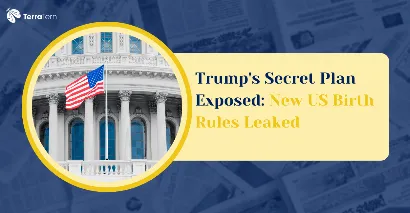Key Highlights
- Trump's Executive Order 14160: What Changes
- USCIS Implementation Blueprint Ready Despite Court Blocks
- Supreme Court Ruling Creates Mixed Legal Landscape
- Ongoing Court Challenges and Class Action Protection
- Impact on Different Visa Categories
- Federal Agency Coordination Plans
- Constitutional and Legal Challenges Ahead
- Conclusion
The US Citizenship Rule Overhaul is still the focus of the legal discussions where the Trump administration plans to organize the full-scale implementation although the court steps against these changes are taken. One of the first and the most controversial executive orders to change the course of American immigration would be Executive Order 14160, signed on January 20, 2025.
Trump's Executive Order 14160: What Changes
Executive Order 14160, titled "Protecting the Meaning and Value of American Citizenship," fundamentally alters who qualifies for automatic US citizenship at birth. The order targets two specific categories of children born on American soil:
Children who would lose automatic citizenship:
-
Those whose mothers were unlawfully present in the US and fathers lacked US citizenship or permanent resident status
-
Those whose mothers held temporary legal status (student, work, or tourist visas) and fathers weren't US citizens or green card holders
Also Read: India Emerges as Second-largest Source Country for New United States Citizens
USCIS Implementation Blueprint Ready Despite Court Blocks
Even as the courts keep the citizenship rule changes on hold, the United States Citizenship and Immigration Services (USCIS) has come up with elaborate lay down plans on how it would implement the changes. These plans speak volumes about how the administration will go about executing the new rules once the legal barriers have been removed.
|
Current System |
Proposed Changes Under New Rules |
|
Birth certificate proves citizenship |
Birth certificate alone is insufficient |
|
Parents don't prove immigration status |
At least one parent must prove eligibility status |
|
Standard federal benefits access |
Federal agencies verify parental status |
Supreme Court Ruling Creates Mixed Legal Landscape in 2025
The decision of the Supreme Court of June 27, 2025, in the case of Trump v. CASA provided a halfway house toward victory to the Trump administration as it left intact the citizenship question. The 6-3 judgment restricted the power of federal judges to grant nationwide injunctions and had nothing to do with the legal justifiability of the birthright citizenship order under the Constitution. Here are key Supreme Court decision points:
-
Limited Nationwide Injunctions: Federal courts can only protect parties directly involved in lawsuits
-
30-Day Implementation Delay: Provided time for lower courts to adjust their orders
-
Constitutional Question Unresolved: Court didn't rule on 14th Amendment interpretation
Also Read: Immigration Relief For Spouses Of US Citizens: Understand Everything
Ongoing Court Challenges and Class Action Protection
Even after the Supreme Court case, several federal justices are continuing to prohibit the executive order under the protection of classes. On July 10, 2025, a federal judge in New Hampshire partook in the certification of a national class action and carried the injunction concerning its enforcement. Here are current legal status:
-
Order remains blocked nationally through a class-action lawsuit
-
Multiple state challenges continue in federal courts
-
Implementation delayed indefinitely pending legal resolution
Impact on Different Visa Categories in 2025
The citizenship rule changes would affect various immigration categories differently, creating a complex landscape for families currently in the US.
|
Visa Type |
Impact Level |
Details |
|
H-1B/H-4 |
High |
Work visa holders' children affected |
|
F-1 |
High |
Student visa holders' children affected |
|
B-1/B-2 |
High |
Tourist/business visitor children affected |
|
TPS |
High |
Temporary protected status holders affected |
|
DACA |
High |
Recipients' children would lose their citizenship |
Federal Agency Coordination Plans
The Trump administration has released guidance documents from multiple federal agencies outlining implementation procedures. The State Department and Social Security Administration have prepared protocols for handling passport and Social Security number applications under the new rules. Here is the agency implementation timeline:
-
USCIS: Policy manual updates prepared
-
State Department: Passport application procedures revised
-
Social Security Administration: SSN issuance protocols modified
-
Department of Homeland Security: Enforcement guidelines drafted
Also Read: F-1 and H-1B Visas: Once the Safest US Path, Now Fraught with Risk
Constitutional and Legal Challenges Ahead
Questions are raised by legal experts about the constitutionality of the executive order, saying the precept of birthright citizenship has more generally been described as being reset by way of amendment to the constitution rather than by way of an executive order. The citizenship clause of the 14th Amendment has a consistent interpretation lasting more than 150 years.
-
Amendment procedures of the Constitution
-
Two-thirds of the House, Senate
-
Three-fourths of the state legislatures must ratify it.
-
The process is deemed unlikely to occur in the current political environment.
Conclusion
The US Citizenship Rule Overhaul continues to face significant legal hurdles as federal courts maintain nationwide injunctions against Executive Order 14160, preventing its implementation despite comprehensive agency preparation. While the Trump administration has developed detailed enforcement protocols across multiple federal departments, constitutional challenges from legal experts and ongoing class-action lawsuits create an uncertain timeline for any potential rule changes. For the most current information on citizenship and immigration policies, visit the official USCIS website. To learn more about U.S visas and citizenship, visit our official website TerraTern now!








